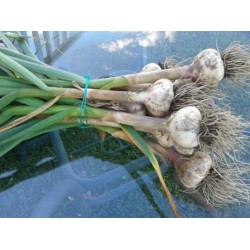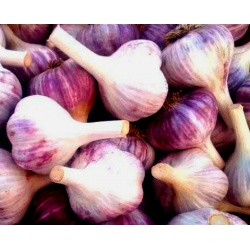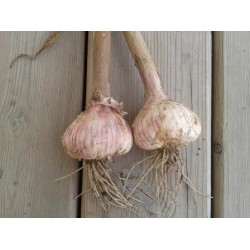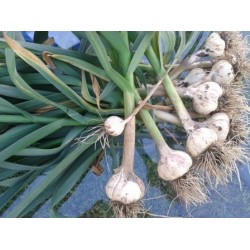
Hardneck vs. Softneck Garlic: Key Differences for Growers
Garlic isn’t just garlic — and if you’re planning to grow it, understanding the difference between hardneck and softneck types can completely change your harvest results. Both belong to the Allium sativum species, but their structure, flavor, and growing habits are quite different.Here’s what every grower should know before choosing which type to plant.
1. Plant Structure: The Neck Tells the Story
The easiest way to tell them apart is by their “neck” — the stem that grows through the center of the bulb.
-
Hardneck Garlic develops a stiff, central stalk (called a scape) that continues above the bulb.
-
Softneck Garlic has no central stalk; its leaves stay soft and flexible, making it ideal for braiding after harvest.
This structural difference influences how they grow, how they’re harvested, and even how long they last in storage.
2. Growing Conditions
Hardneck Garlic thrives in cold climates and regions with a true winter chill. The bulbs need a period of vernalization (cold exposure) to form large cloves.
Softneck Garlic, on the other hand, grows best in mild or warm climates, where winters are shorter and frost is less intense.
| Type | Best Climate | Winter Chill Needed |
|---|---|---|
| Hardneck | Cold / Temperate | Yes |
| Softneck | Warm / Mild | Minimal |
If you live in a northern region, hardneck garlic is your go-to. Southern growers will usually have better success with softneck types.
3. Scapes: A Unique Bonus for Hardneck Growers
Hardneck garlic sends up a flowering stalk called a scape — a curly, green shoot that appears in early summer. Scapes are not only beautiful but edible, with a mild garlic flavor that’s great in stir-fries and pestos.
Softneck garlic doesn’t produce scapes, so if you want that extra harvest, hardneck is the way to go.
4. Flavor Profile
Hardneck garlic varieties typically offer richer, spicier, and more complex flavors — ideal for gourmet cooking and small-batch markets.
Softneck garlic tends to have a milder, less pungent taste and is the type most often found in grocery stores.
| Type | Flavor | Common Uses |
|---|---|---|
| Hardneck | Bold, robust, sometimes spicy | Fresh use, artisan cooking |
| Softneck | Mild, mellow | Everyday cooking, braiding, bulk storage |
5. Bulb & Clove Characteristics
-
Hardneck Garlic:
-
Fewer, larger cloves (usually 4–10 per bulb).
-
Easier to peel.
-
Typically shorter storage life (4–6 months).
-
-
Softneck Garlic:
-
Many smaller cloves (up to 20 per bulb).
-
Harder to peel.
-
Excellent storage life (up to 9–12 months).
-
For chefs and home cooks who value flavor and easy prep, hardneck varieties win. For commercial growers needing long shelf life, softneck is often preferred.
6. Propagation: Bulbs and Bulbils
Hardneck garlic can reproduce through both bulbs (cloves) and bulbils, small seed-like structures that form in the scape. Bulbils allow growers to multiply seed stock naturally, preserving garlic genetics and reducing disease risk.
Softneck garlic typically reproduces only by planting individual cloves from the bulb.
✅ Key Takeaways
| Feature | Hardneck Garlic | Softneck Garlic |
|---|---|---|
| Climate Suitability | Cold / Temperate | Warm / Mild |
| Neck Type | Hard central stalk | Flexible leaves |
| Scapes | Yes (edible) | No |
| Flavor | Rich, bold, complex | Mild, mellow |
| Storage Life | 4–6 months | 9–12 months |
| Propagation | Bulbs + Bulbils | Bulbs only |
Which Should You Grow?
If you live in a cool or northern region and love bold garlic flavor, choose hardneck garlic seed bulbs or bulbils.
If you’re in a warmer area or want long-lasting bulbs for storage or braiding, go for softneck garlic.
Many growers plant both — hardneck for gourmet flavor and scapes, softneck for bulk kitchen use.
Explore our collection of premium garlic seed bulbs and bulbils — carefully selected for performance and robust flavor.
Grow garlic that’s as bold as your harvest.







9 Comment(s)
Kindly give me your phone specs and I'll tell you if it is possible without an PC.
I need to to thank you for this wonderful read!! I absolutely loved every little bit of it. I have got you book marked to check out new things you
Ahaa, its pleasant discussion on the topic of this piece of writing at this place at this website, I have read all that, so at this time me also commenting here.
Terrific post however , I was wanting to know if you could write a litte more on this topic? I'd be very grateful if you could elaborate a little bit more. Kudos!
Hi, I do believe this is an excellent web site. I stumbledupon it ;) I may come back once again since I saved as a favorite it. Money and freedom is the greatest way to change, may you be rich and continue to help others.
I wanted to thank you for this good read!! I definitely enjoyed every little bit of it. I've got you bookmarked to look at new things you
What's up, just wanted to tell you, I enjoyed this blog post. It was funny. Keep on posting!
These are really impressive ideas in regarding blogging. You have touched some good factors here. Any way keep up wrinting.
Ahaa, its nice dialogue regarding this piece of writing here at this web site, I have read all that, so now me also commenting at this place.
Leave a Comment